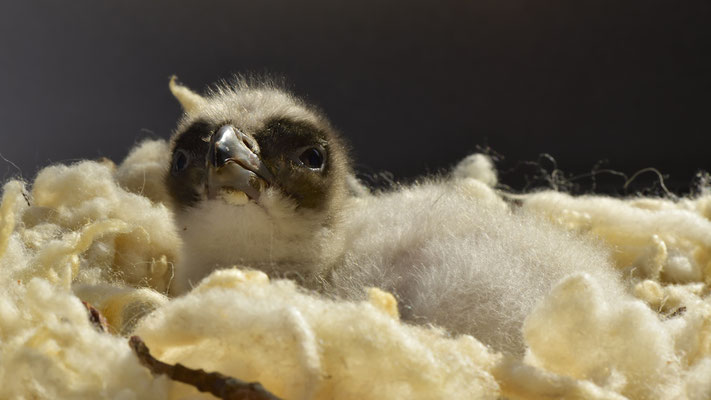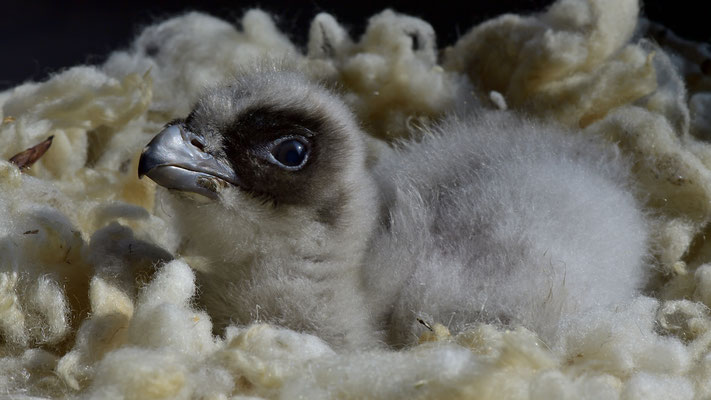
Yesterday, on Friday 21 February 2020, the Vulture Conservation Foundation (VCF) rejoiced when they welcomed BG1057, the second chick to hatch at Vallcallent Specialised Breeding Centre this season! The chick is now the fourth to hatch within the VCF coordinated Bearded Vulture Captive Breeding Network (Bearded Vulture EEP), which breeds the species in captivity to help reintroduce or reinforce their populations in the wild.
Bearded Vulture BG1057

Yesterday the day at Vallcallent started bright and early, with BG1057 artificially hatching between 6:00 – 7:00 am. Its nabel was completely closed, there was almost no swelling on its neck and it weighed 158,1g.
The team was anticipating the hatching for the last couple of days since many positive signs were indicating this would happen soon! On 13 February, the air cell displacement started and a few days later on 18 February, around 2:00 pm, the chick pecked its air cell. Then yesterday, on 20 February at 8:15 am, the chick pecked the eggshell. A few hours later, at 7:00 pm, the chick started hatching but stopped completely at 7:30 pm after opening one-fourth of the eggshell. Fast-forward to Friday, and BG1057 artificially hatched between 6:00 – 7:00 am. Now the team at the centre will look after the chick continuously, until it is ready to be adopted by Bearded Vultures at the centre. Let’s hope the chick will grow healthily and that it will be smoothly adopted.
Tejo and Dama – the parents of BG1057
Tejo (male) and Dama (female) are the biological parents of the chick. This season they laid four fertile eggs, which will be a new record if all the eggs hatch, and this is their first chick to hatch for the year. There is quite a big age difference between the two, but it works! The male hatched in 2001 and the female in 1988. It took some time until the two found each other and were able to become parents, but all is developing well ever since!
Dama is a very aggressive bird, and she would not accept pairing with adult males before she met Tejo. At the early stages of her life, there was a mistake in her sex determination and was considered male and was housed with a male until 1992. Following that, they paired her with a female until 1995. Because of their behaviour, they tested her gender again and they discovered she was female.
So, the network then tried to pair her with four different adult males between July 1995 and November 2003 but with no success. Then, they paired her with Tejo. As a young bird, Tejo was dominant, and she finally accepted him – it seems that Dama had something specific in mind!
But, there were still quite a few issues that followed after she started laying eggs. She is very nervous when she lays a clutch and buries most of her eggs under the wool, which threatens the chances of hatching. So, they removed her clutches and incubated them by other pairs, and for the last few years, they are artificially incubated at the centre in Vallcallent. Additionally, she doesn’t adopt chicks, so it is not possible to use her as a foster female and thus she will not adopt BG1057. Thanks to human intervention, the pair has produced a total of 21 fledglings in the past 12 breeding seasons. Dama might not be so easy to work with, but she is still a valuable member of the Bearded Vulture EEP with a strong personality for sure!
Vallcalent Specialised Breeding Centre
The Centre de Fauna de Vallcalent is property of the Generalitat de Catalonia. Thanks to an agreement the VCF made with Generalitat de Catalonia, the VCF is managing the Bearded Vulture Specialised Breeding Unit within the centre.
There are currently three breeding pairs in Vallcalent, and two additional pairs that reached their sexual maturity, but did not breed this year. These pairs are the most challenging ones within the Bearded Vulture EEP and are sent to Vallcalent Specialised Breeding Centre because with the expertise and experience of Alex Llopis (VCF’s Vultures Captive Breeding Manager & Bearded Vulture EEP Coordinator) and the facilities at the centre these pairs have a better chance of breeding.
Captive-breeding Bearded Vultures
The Vulture Conservation Foundation (VCF) coordinates the Bearded Vulture Captive Breeding Network (EEP) of zoos, specialised breeding centres, recovery centres and private collections. This involves closely working with our colleagues across Europe to ensure the best breeding results from the 178 birds within the Network. They first reported on the breeding season kicking-off in early October, the egg laying period starting in December and the first chick hatching in January!
To follow the news of the breeding season, follow #BeardedVultureBreedingSeason on Facebook, Twitter, Instagram and LinkedIn.







